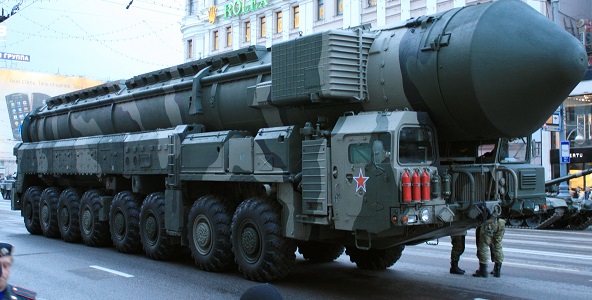The US-Russia nuclear tussle
April 12, 2019 | Expert Insights

America and Russia are currently engaged in a legal, normative and political battle to ensure their nuclear advantage, although this may mean a new nuclear arms race.
Background
Measures for the Further Reduction and Limitation of Strategic Offensive Arms or the Strategic Arms Reduction Treaty (New START) is an agreement between the United States and Russia that reduced in half the number of strategic nuclear missile launchers. While the treaty does not limit the number of operationally inactive and stockpiled nuclear warheads, it would introduce an inspection and verification regime to ensure compliance. The deal is a part of a number of historical treaties that sought to reduce weapons deployments and tensions between the nuclear superpowers and was signed on April 8, 2010, between President Obama and his Russian counterpart Dmitry Medvedev.
A number of strategic arms reduction treaties have recently come under fire under the Trump administration, including the Intermediate-Range Nuclear Forces Treaty (INF). According to the reports, during President Trump’s first 60-minute phone call with Russian President Vladimir Putin, Mr. Putin inquired about extending the New START treaty. The treaty is due to expire in 2021, although it contains an option to extend until 2026. Mr. Trump subsequently attacked the primary tenets of the treaty, arguing that it unduly favoured Russia and was “one of several bad deals negotiated by the Obama administration.
Analysis
US Secretary of State Mike Pompeo said that Washington was willing to extend the New START treaty if Russia and America could agree to terms that are amenable to both sides. Mr. Pompeo said, “There is large compliance with the New START. On both sides, there are some arguments on edges, but largely the Russians and the United States have been compliant… If we can get the deal right, if we can make sure it fits 2021 and beyond, President Trump has made very clear that if we can get a good solid arms control agreement, we ought to get one.”
Mr. Pompeo’s statements indicate that the US position on Russia’s strategic nuclear arsenal is more nuanced than what the deep-rooted opposition to the INF Treaty indicates. Given that the INF treaty is limited in scope compared to the New START agreement, it is likely that Mr. Pompeo’s State Department seeks to temper concerns that both sides seek the removal of both treaties, escalating the chances of nuclear war.
Russian Deputy Foreign Minister Sergei Ryabkov has voiced concern over a technical disagreement the Russians have with the Americans. In the Russian estimation, America has designated a number of submarine launchers and heavy bombers for non-nuclear use, meaning they are no longer a part of the inspection regime. Mr. Ryabkov contends that Russia raised these concerns with their American counterparts and received no response. Russia has repeatedly stated that it is seeking an extension on the New START treaty. While there is no telling if this stated intention is sincere, what is clear is that America believes that Russia broke the INF Treaty, resulting in the withdrawal of both parties from the agreement, freeing them to develop and deploy new missiles.
US Air Force Gen John Hyten, commander of US Strategic Command which oversees America’s nuclear program, has expressed concern that Russia is developing strategic weapons outside the purview of the New START treaty. Gen Hyten has called for an expansion of New START’s jurisdiction would include the entirety of both countries capabilities, particularly emphasising the need for robust compliance procedures.
The fine print of both deals highlights how treaties pertaining to weaponry quickly outgrow technological advancements in the field. For example, among the primary considerations for both the INF Treaty and New START are ballistic missiles. However, countries are free to research hypersonic missiles. This is of primary concern for both parties, as both countries are unable to accurately estimate the capabilities of the other, as expressed in Gen Hyten’s statements.
Assessment
Our assessment is that the distrust of both Russia and the United States over the others’ nuclear capabilities results in unilateral pull-outs of treaties designed to propagate trust and reduce the chances of nuclear Armageddon. We believe that both countries need to engage in trust-building measures, perhaps augmented by broad reaching compliance protocols that can satisfy concerns over each other's capabilities. We believe that if these treaties are abandoned, a nuclear arms race marked by technological innovation is likely. We believe that Mr. Pompeo’s recent statements are intended to help ensure that the broad-reaching New START deal does not lapse, while the American position on the INF Treaty is designed to show that it remains committed to ensuring Russia does not secure the advantage.
Image Courtesy: https://bit.ly/2suUeMa ru:Участник:Goodvint [CC BY-SA 3.0 (https://creativecommons.org/licenses/by-sa/3.0)]








Comments